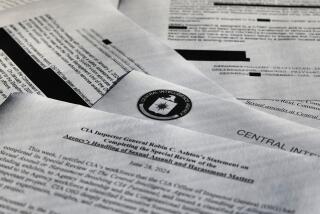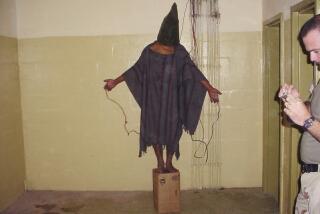CIA inquiry will target contractors
- Share via
WASHINGTON — The Justice Department prosecutor appointed this week to examine the CIA’s interrogation program will revisit long-dormant abuse cases involving the agency’s civilian contractors, bringing new attention to a little-known but controversial element of the Bush administration’s war on terrorism.
Civilian contractors used by the CIA at secret overseas facilities were accused of detainee abuses and deaths in a series of cases in the years following the U.S.-led invasions of Afghanistan and Iraq, but only one was ever prosecuted.
The contractors also played a key but secret role in the CIA’s interrogations of top Al Qaeda suspects at “black site” prisons overseas.
The new scrutiny will be a central part of the preliminary review by federal prosecutor John H. Durham, according to Justice Department officials and others familiar with the review.
Durham was appointed this week by Atty. Gen. Eric H. Holder Jr. in a move that provoked sharp criticism from both ends of the political spectrum.
Conservatives fear that Durham’s assignment will become a “witch hunt” targeting well-meaning intelligence officers. Liberals want the veteran prosecutor to go after the political and legal architects of the Bush administration’s “enhanced interrogation” program.
But indications are that the scope of Durham’s assignment may be limited to a dozen or so cases, most of which already have been the subject of several reviews. He may be able to expand his purview later, especially if he recommends a full-scale criminal investigation after concluding the preliminary review.
The investigation could then delve into whether CIA supervisors and officials at agency headquarters knew about or authorized interrogators’ use of tactics that went beyond those approved in Justice Department legal memos.
In recent years, the U.S. military’s use of civilian contractors has been the subject of reviews, criminal trials, congressional hearings and public debate, especially in the aftermath of the prisoner abuse scandal at Abu Ghraib prison in Iraq.
The use of civilian interrogators by the CIA had received less public scrutiny before the Obama administration released previously secret Justice Department legal memos. New details were contained in a 2004 report by the CIA inspector general that was declassified and released this week.
Much of the CIA interrogation program was farmed out to civilian contractors, in part because the spy agency had stopped questioning insurgents and suspected terrorists amid charges that it supported torture in Latin America and elsewhere in earlier decades.
By the time of the Sept. 11 attacks, the agency had few experts on interrogation tactics and brought in civilians in a crash effort to glean intelligence from suspected terrorists, according to the inspector general’s report and other U.S. officials and documents.
“They certainly used a lot of contractors, particularly in the immediate post-9/11 activity when there was just a tremendous gear-up that was needed and a lot of people were brought [in] on contract,” said a former federal prosecutor who now works with CIA clients, and spoke on condition of anonymity.
Compounding the problem was the fact that the CIA hastily launched the interrogation program and provided little authoritative guidance to those in the field about what they could and could not do, the inspector general’s report said.
That lack of guidance could undermine potential prosecutions because the Justice Department would have to prove that the interrogators intended to cause grave harm to the detainees.
Two contractors were closely associated with the enhanced interrogation program: Bruce Jessen and Jim Mitchell, both former Pentagon officials who are regarded as architects of the CIA’s use of waterboarding, which simulates drowning, and other methods.
They are among a broader roster of contractors and operatives assigned from other agencies. One, David A. Passaro, convicted two years ago in the 2003 beating death of an Afghan detainee, was a civilian contractor working for the CIA.
In 2004, the CIA referred at least 19 other cases of suspected abuse to the Justice Department for possible prosecution. But the department concluded that it could not bring prosecutions in at least 17 of them and has not filed charges in any of the others.
A month ago, Amnesty International USA wrote Holder to demand more details about those cases.
“We’ve been calling for this to happen literally for years, so for us it doesn’t come a minute too soon,” Amnesty’s Erica Razook said of Durham’s investigation.
Holder confirmed this week that his Office of Professional Responsibility had recommended that some of those cases be reopened.
But Durham is expected to face a succession of obstacles, including incidents that occurred in faraway places where little if any evidence was gathered or witnesses identified, said current and former Justice Department officials and outside lawyers familiar with some of the cases.
“The likelihood that you’re going to come up with prosecutable cases this many years later is pretty slim,” said the former federal prosecutor who now works with CIA clients.
--
Greg Miller in the Washington bureau contributed to this report.
More to Read
Sign up for Essential California
The most important California stories and recommendations in your inbox every morning.
You may occasionally receive promotional content from the Los Angeles Times.










